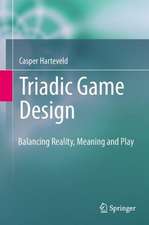Introduction to Modeling for Biosciences
Autor David J. Barnes, Dominique Chuen Limba Engleză Paperback – 4 noi 2014
Preț: 419.37 lei
Preț vechi: 524.21 lei
-20% Nou
Puncte Express: 629
Preț estimativ în valută:
80.27€ • 87.22$ • 67.47£
80.27€ • 87.22$ • 67.47£
Carte tipărită la comandă
Livrare economică 17-23 aprilie
Preluare comenzi: 021 569.72.76
Specificații
ISBN-13: 9781447159070
ISBN-10: 1447159071
Pagini: 336
Ilustrații: XII, 322 p.
Dimensiuni: 155 x 235 x 18 mm
Greutate: 0.47 kg
Ediția:2010
Editura: SPRINGER LONDON
Colecția Springer
Locul publicării:London, United Kingdom
ISBN-10: 1447159071
Pagini: 336
Ilustrații: XII, 322 p.
Dimensiuni: 155 x 235 x 18 mm
Greutate: 0.47 kg
Ediția:2010
Editura: SPRINGER LONDON
Colecția Springer
Locul publicării:London, United Kingdom
Public țintă
ResearchCuprins
Foundations of Modeling.- Agent-Based Modeling.- ABMs Using Repast and Java.- Differential Equations.- Mathematical Tools.- Other Stochastic Methods and Prism.- Simulating Biochemical Systems.
Recenzii
From the reviews:
“The intersection of biological and computational sciences is well served by this clear, well-written, and interesting guide to the variety of methods currently being used to formulate computational models for biological systems. … the book very accessible to a wide range of readers--from students to experienced researchers--from a variety of backgrounds. … Thus, this volume is very timely. … Overall, this book is an excellent and approachable introduction to biological modeling.” (Sara Kalvala, ACM Computing Reviews, May, 2011)
“The intersection of biological and computational sciences is well served by this clear, well-written, and interesting guide to the variety of methods currently being used to formulate computational models for biological systems. … the book very accessible to a wide range of readers--from students to experienced researchers--from a variety of backgrounds. … Thus, this volume is very timely. … Overall, this book is an excellent and approachable introduction to biological modeling.” (Sara Kalvala, ACM Computing Reviews, May, 2011)
Textul de pe ultima copertă
Computational modeling has become an essential tool for researchers in the biological sciences. Yet in biological modeling, there is no one technique that is suitable for all problems. Instead, different problems call for different approaches. Furthermore, it can be helpful to analyze the same system using a variety of approaches, to be able to exploit the advantages and drawbacks of each. In practice, it is often unclear which modeling approaches will be most suitable for a particular biological question - a problem that requires researchers to know a reasonable amount about a number of techniques, rather than become experts on a single one.
Introduction to Modeling for Biosciences addresses this issue by presenting a broad overview of the most important techniques used to model biological systems. In addition to providing an introduction into the use of a wide range of software tools and modeling environments, this helpful text/reference describes the constraints and difficulties that each modeling technique presents in practice. This enables the researcher to quickly determine which software package would be most useful for their particular problem.
Topics and features:
David J. Barnes is a lecturer in computer science at the University of Kent, UK, with a strong background in the teaching of programming.
Dominique Chu is a lecturer in computer science at the University of Kent, UK. He is an expert in mathematical and computational modeling of biological systems, with years of experience in these subject fields.
Introduction to Modeling for Biosciences addresses this issue by presenting a broad overview of the most important techniques used to model biological systems. In addition to providing an introduction into the use of a wide range of software tools and modeling environments, this helpful text/reference describes the constraints and difficulties that each modeling technique presents in practice. This enables the researcher to quickly determine which software package would be most useful for their particular problem.
Topics and features:
- Introduces a basic array of techniques to formulate models of biological systems, and to solve them
- Discusses agent-based models, stochastic modeling techniques, differential equations and Gillespie’s stochastic simulation algorithm
- Intersperses the text with exercises
- Includes practical introductions to the Maxima computer algebra system, the PRISM model checker, and the Repast Simphony agent modeling environment
- Contains appendices on Repast batch running, rules of differentiation and integration, Maxima and PRISM notation, and some additional mathematical concepts
- Supplies source code for many of the example models discussed, at the associated website http://www.cs.kent.ac.uk/imb/
David J. Barnes is a lecturer in computer science at the University of Kent, UK, with a strong background in the teaching of programming.
Dominique Chu is a lecturer in computer science at the University of Kent, UK. He is an expert in mathematical and computational modeling of biological systems, with years of experience in these subject fields.
Caracteristici
Presents a broad overview of the most important techniques used to model biological systems Provides a detailed introduction to agent-based models, stochastic modelling techniques and differential equations for the novice modeler With exercises, and a companion website featuring software and sample programs, as well as downloadable sample code










